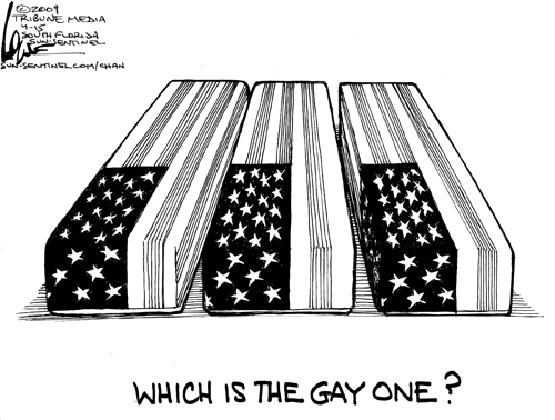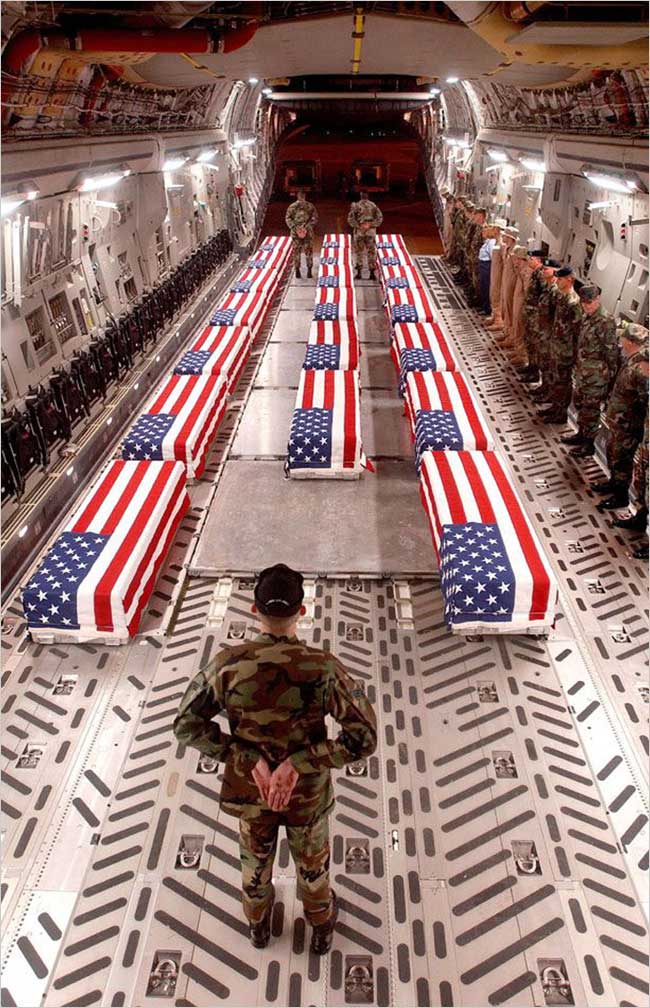
Image credit: Chan Lowe, The Lowe Down
The above cartoon, republished yesterday on the artist’s blog, makes a very effective argument against Don’t Ask, Don’t Tell. The use of flag-draped coffins, signifying shared tragedy, suggests that dying for one’s country has little to do with sexual orientation and that is rather the work
that an individual does—in this case, sacrificing his/her life for the United States—that matters. In this kind of public sacrifice, the image suggests, everything individual is erased. However, this message seems more complicated when considered in relation to one of Tim Turner's earlier posts and the wider cache of meanings that these coffins suggest.
 Image credit: thememoryhole.org, via Associated Press, NYT,2/15/2009
Image credit: thememoryhole.org, via Associated Press, NYT,2/15/2009
Last year, Tim discussed speculation as to whether President Obama would change Pentagon policy and allow the publication of photographs of flag-draped coffins returning from the wars in Iraq and Afghanistan. Tim suggested that this debate was in large part about the tension between public and private sacrifice (a difficulty that the eventual solution addressed), although there are obvious issues of information control as well.
When thought of in the context of public/private tension, Lowe’s cartoon could also be translated as an argument for making these coffins visible, as the coffins signify an act of public sacrifice, the death of a soldier, rather than a man or woman. The suggested erasure here could also be troubling in the debate on DADT. Lowe’s image’s suggestion that being a soldier is an overriding identity seems like it could actually be appropriated as an argument for DADT, suggesting that, in the military, you are a soldier above all else and can therefore be told to conform to gender and sexuality standards. Obviously,that argument is problematic (why these standards?) and extremely discriminatory, but it makes visible some of the complications that arise in the public/private tension around soldiers’ bodies.
Tim’s original piece is below, and here. For more discussion of images and DADT, see this recent post on No Caption Needed.
Start of Tim's post:
At his first televised press conference last week, President Obama received a question about a controversy that, though once debated quite energetically, had seemed for a time to recede into the background as the casualty rate for U.S. soldiers has fallen. The questioner wanted to know whether the new administration would order the Pentagon to reverse its policy of forbidding the publication of photographs showing the return of fallen soldiers from the wars in Iraq and Afghanistan. (President Obama responded by not commenting, since the policy is currently "under review.") Image credit: thememoryhole.org, via Associated Press, NYT, 2/15/2009
Image credit: thememoryhole.org, via Associated Press, NYT, 2/15/2009
The question, and the issue, were covered yesterday by The New York Times in a story and an editorial urging the President to overturn the policy. As the author of the former summarizes the issue, "Part of the debate that has developed turns on whether the return of soldiers is a private or public matter. While families have registered a range of opinions about allowing the news media at Dover, many have maintained that the return of a body is so deeply personal that they should be able to decide whether to keep it private." Above and beyond the questions raised by the difficult question of how to treat the images of what is essentially both a public and a private sacrifice (a soldier dying for his or her country is also lost to his or her family), the debate itself is simply a reminder of the power of images to move arguments.
Recent comments
2 years 29 weeks ago
2 years 44 weeks ago
2 years 44 weeks ago
2 years 50 weeks ago
3 years 4 weeks ago
3 years 4 weeks ago
3 years 4 weeks ago
3 years 6 weeks ago
3 years 6 weeks ago
3 years 6 weeks ago